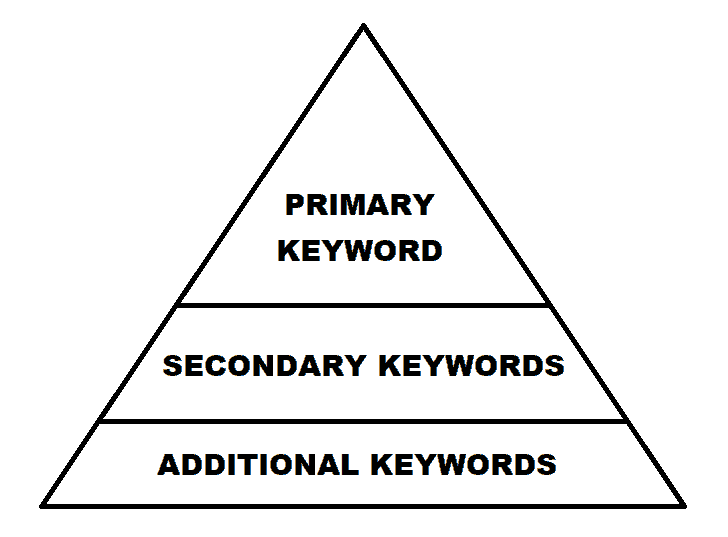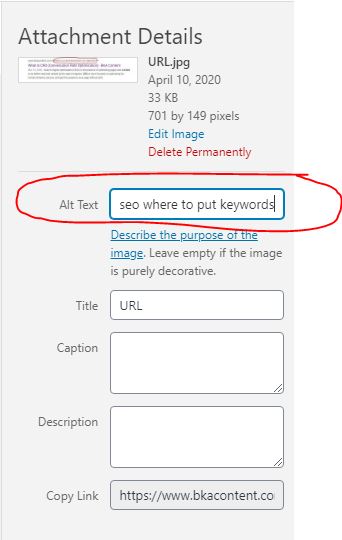Posted At: Oct 02, 2023 - 255 Views

While there are many opinions on how keywords should be researched and used, I want to provide you with a basic and quick step-by-step guide on how to correctly and safely use keywords in any type of content that you write/post.
How Many Keywords Should You Use On A Page?
When talking about how many keywords to focus on in a page, the answer depends a lot on the keywords you are wanting using, how related they are to one another, and if they help push the message of the content forward. With the right keyword research, though, it shouldn’t be too hard to come up with a list of 5-10 keywords. That being stated, it doesn't mean you should concentrate on each of the 10!
Let’s first discuss the rules of keyword hierarchy. There are 3 main types of keywords:
- Primary Keyword
- Secondary Keywords
- Additional Keywords
Your primary keyword is the main focus of the entire article, so the title and ensuing content should reflect that. You can’t really write a good piece of content about 2 separate topics, so only one primary keyword should be used.
Secondary keywords are complementary keywords to the primary one, but just slight variations. Usually, the main topic will include 3-5 main talking points so using a handful of those secondary keywords makes sense.
Additional keywords are just any other related keywords that are phrased or spelled differently than the first two but mean the same thing. This is a catch-all net to try and get different variations of your main keywords in there to try and rank for all of them.

So Again, How Many Keywords for SEO?
In most cases, it would be 3-8 total, based on the length of the content. This breaks down into 1 primary keyword, 1-3 secondary keywords and 1-4 additional keywords. This gives you a fighting chance to start ranking for one of them and then further down the line you can even re-optimize your content based on what it’s currently ranking for.
Using more keywords than 8 or so (assuming you don’t have either insanely long content or extremely short content) can come off as spammy, is incredibly hard to incorporate into natural writing for a content writer, and really isn’t necessary. What you’ll find is that related keywords will naturally and automatically come up when writing content based around a few really good keywords. Doing more than this usually hurts readability and sticks out like a sore thumb to readers as well as Google’s page crawlers.
Where To Use Keywords in Your Content Writing
It’s easy to just say “you need to add keywords for SEO”, but implementing it is a different matter entirely. In fact, there are certain rules and best-practices for adding keywords to a website that can make your efforts much more worthwhile.
You should insert keywords into your content writing using the following steps:
1. Use Keywords in Your Meta Description
This is one of the most basic ways to add keywords for SEO, but it’s often overlooked. The meta description acts as a simple summary to describe what the content is about, so placing the keyword in this summary helps Google to better filter your results. It’s is a powerful way to get 1 or 2 of your most important keywords attached to a part of your page that’s directly served up by search engines.
As a refresher, a Meta Description is a 160 character (or 20-25 word) description of what your page is all about. This description is what shows up under a page name and URL when people search for a keyword phrase on search engines. Here is an example of a Meta Description as it appears on the Search Engine Results Pages (SERPs).

How to Use Keywords for SEO in a Meta Description
First, it’s important to have the right tools. If you’re using WordPress, try downloading the Yoast SEO Plugin. This little plugin allows you to quickly optimize your content for both SEO and readability, as well as gives you spots to enter in your Meta Description and SEO Title Tag (see step #2).
Next, when using SEO keywords in a meta description make sure to use the keyword at least once, but no more than twice. Be sure to prioritize a helpful, enticing description over keyword stuffing though, since this is the first thing someone will read before ever visiting your website.
SEO Pro Tip: If you can get a secondary keyword in your meta along with one instance of your primary, you’re killing it when it comes to using keywords for SEO.
2. Insert Keywords in Your SEO Title Tag
Keep in mind, I said SEO title, not your main article title. You’ll be optimizing that in just a minute. First things first, let’s get some helpful keyword data in your SEO title tag (also known as a meta title tag). This title tag is similar to the meta description in that it is the name of the page that users will see on search engine results pages (SERPs) when they search a keyword phrase. This title will be clickable from the SERPs and will take the user directly to your page. Here is an example:

How to Write Keywords for SEO in a Meta Title Tag
Similar to meta descriptions, you only have a few characters (about 50-60) to use when writing your SEO title tag. Because of that, you typically want to limit your title tag to just your primary keyword as well as your company name. This is the most concise, user-friendly, and SEO-friendly way to execute it.
3. Use Keywords in Your Article Title
If possible, put the keyword in the title of your content. Since Google pairs this title header with your meta description to paint a picture of what your content is about, having the keyword in the title is very helpful as long as it can be used naturally.
If the keyword can’t be used naturally in the title, use a variation that still gets the point of the article across while hitting some of the main words from your keyword phrase. A little is better than nothing!
4. Use Keyword Within the First 200 Words
Many experts believe that Google gives more weight to the first 200 words in your content. The reason why is because usually, the first 100-200 words of an article are where a content writer sets up the introduction of what will be discussed. Since most readers only continue on in an article if the introduction is good, it stands to reason that it could be a ranking factor as well.
Where to Use Keywords in an Article Introduction
Knowing that Google scrutinizes the first 200 words of a blog post, it’s very important to make sure that you put your primary keyword within the first sentence or paragraph if at all possible without sacrificing the quality of the content. Similarly, you should try to use at least one secondary keyword in the first 200 words as well (though not in the first sentence).
Keep in mind that Google is trying to get an overall picture of what the article is all about. You have to be careful to lead Google to where you want to go and not confuse it when optimizing content for keywords. This means your primary keyword should live in all the most important places, your secondary keywords next, and then any other additional keywords after that. Think of it as a pyramid of usage, with primary keywords at the top.
The focus of the article (and introduction) would be the top of the primary, filled in by secondary, and lastly additional keywords to make up an entire keyword structure and strategy for that piece.

5. Insert Keywords Naturally Throughout the Article
In a seemingly SEO-centered digital world, it’s easy to forget that the reader actually comes first. You should never compromise your reader’s ability to be engaged, informed, and enlightened by your content because of bad keyword placement. But believe me, it happens all the time. Here is one solution to help you write your keywords more naturally in your content.
Use Stop Words in Awkward Keyword Phrases
One way to help you write keywords more naturally is to utilize “Stop Words” in your keyword writing. These are words that can be added within keyword phrases to help them read more naturally without decreasing their ranking value.
For instance, if you had a keyword phrase you were targeting that reads “plumbing Salt Lake City”, there is literally no way you can insert it into your content exactly as-is without it either looking like a typo or a blatant keyword insertion. The better way to add keywords for SEO is to use a stop word in that phrase. Adding the stop word “in”, would now have it read “plumbing in Salt Lake City”, which can much more easily be inserted into natural writing. Try it out!
You can easily find a list of commonly used stop words you can utilize when adding keywords to your website.
How Many Keywords Should You Put in Your Content?
This is a great question that’s often discussed and argued about among SEOs. The real answer is that it completely depends on the types of keywords you have and the length of your content.
The general rule, however, is you should try to include your primary keyword about once every 100-150 words. So if you’re writing a 1000 word article, inserting the primary keyword around 7-10 times would be appropriate. Also keep in mind that you want to fairly distribute these instances of the keyword throughout the article. You don’t want all 7 instances of your primary keyword in the same 200-word section or you lose the flow of a consistent keyword theme throughout.
Secondary and Additional keywords, however, shouldn’t be in the article more than your primary keyword. Whatever your baseline is for using your primary keyword in your content, decrease by about 25% for secondary and another 25% for additional keywords. Then you can keep a healthy keyword structure that Google crawlers should easily be able follow.

6. Use Keywords in the Last 200 Words
Similar to how an introduction of an article is important because it sets the framework for the content, the conclusion (or last 200 words) could be argued is just as important if not more important. For this reason, try to include your primary keyword again near the last or second to last paragraph and include a secondary keyword if possible.
For blog posts, it’s usually good practice to include a call-to-action (or CTA) in the very last paragraph, so if you can fit the primary keyword there great! If not, get it in that second to last paragraph like we talked about above.
7. Use Keywords in Headers or Headings (H1s, H2s, H3s, etc)
Heading (or headers) is a formatting tool that most text editors offer to allow you to help break up your text. From a purely visual standpoint, they are a must-have. Huge chunks of paragraph content with no end in sight are intimidating and often skipped completely. Using headers to break up content allows you to visually move the reader along to the most important points, or the ones they are most interested in.
From an SEO standpoint, headers might be even more important. The HTML tags used to identify H1s, H2s, H3s, etc are also ranking signals for Google to know what’s most important in the content. Adding keywords to headers in the content may be the single best way to try and rank for multiple keywords. The more content you have, the more headers you have – so longer content usually ranks better than shorter content.
When a keyword is used in headings, it brings more emphasis to the meaning and importance of the keywords. This helps the search engines to know how relevant those keywords are to your content. Here’s an example of where to find heading formats in a text editor:

How to Add Keywords to Heading 1s (H1s)
Heading 1s, or H1s, are typically reserved just for the main title of the article. If you use multiple H1s in your content, you’re basically asking Google to get confused. Instead, just stick to a single H1 as your article title with your primary keyword included.
How to Use Keywords in Heading 2s (H2s)
Heading 2s, or H2s, are where you can do the bulk of inserting important keywords. H2s are the headers that break up the main sections of your content and usually come into play every couple hundred words. For a 1000 word article, you can plan on around 3-5 of these H2s. this is where you’d want to include the primary keyword again in one of them and reserve the rest for secondary keywords you are targeting.
How to Insert Keywords to Heading 3s (H3s)
Heading 3s, or H3s, are used to help break up and list individual points in the main sections. You might find H3s in the form of numbered lists or clarifying sections to an H2 heading. This is another good place for an instance of the primary, but probably a better spot for secondary keywords and any additional keywords you have.
8. Use Keywords in Anchor Text Links
When a keyword is used as an anchor text link in your content, it implies that there is a place to find even more information regarding that word. This helps to place added emphasis on the keyword and the relevance it has to the content. So how does that apply to the article you’re currently writing?
Well, it doesn’t. Not exactly. Using keywords as anchor text links in your articles can help OTHER pages on your site. This is also known as creating an internal link structure showing Google where the most important articles are for exact keyword phrases. If you can plan your content accordingly, you know you can use anchor text links of certain keyword phrases to drive the authority of other “pillar” pieces.
9. Use Keywords in Image Alt-tags
First of all, if you aren’t using images in your content writing then PLEASE do so! I can’t overemphasize how many opportunities you’re missing out on if you aren’t using some kind of visual cue to help educate, engage and inform your readers and prospective clients. Images and content writing (and videos for that matter) are a perfect marriage when it comes to user engagement.
How to Use SEO Keywords in Alt Tags
In terms of keyword usage, using your keywords in an image alt-tag can help it to be shown during image searches. This can help users to be led to your content in a round-about way.

Not only do images help break up the text and give it color, personality and sex appeal, it also can be a great opportunity for you to add keywords to your website. Take advantage of putting images in your articles and the blessed alt-text you’re allowed to manipulate.
10. Use Keywords in URL
Last, but not least, when it comes to adding keywords to your website, you should always try to put your primary keyword in the main page URL of the article you’ve written. If you’ve done the steps above and put your primary keyword in the title of your article, it should be in the URL automatically when you go to publish it. But even if your title is similar to the main keyword but doesn’t include it completely, you should tweak your page URL to include it after the fact. Here is an example:

There has often been talk among SEOs and content marketers of whether or not it’s necessary to put your primary keyword into your page URL and if it affects rankings. Based on a study we did here at BKA Content, analyzing around 60 posts over a 6 month period, the posts we had with a keyword as a part of the page URL were overwhelmingly ranking for that exact keyword. That’s enough evidence for me that it IS effective to include the keyword in the page URL.
